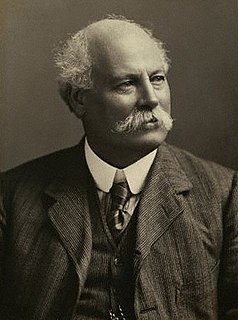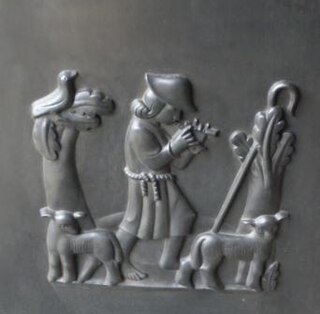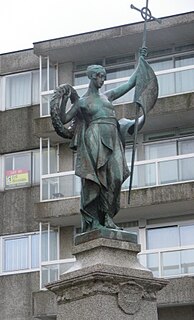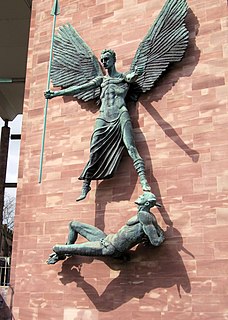Related Research Articles

Sir Thomas Brock was an English sculptor and medallist, notable for the creation of several large public sculptures and monuments in Britain and abroad in the late nineteenth and early twentieth centuries. His most famous work is the Victoria Memorial in front of Buckingham Palace, London. Other commissions included the redesign of the effigy of Queen Victoria on British coinage and the massive bronze equestrian statue of Edward, the Black Prince, in City Square, Leeds.

Sir George James Frampton, was a notable British sculptor. He was a leading member of the New Sculpture movement in his early career when he created sculptures with elements of Art Nouveau and Symbolism, often combining different materials such as marble and bronze in a single piece. While his later works were more traditional in style, Frampton had a prolific career in which he created many notable public monuments, including several statues of Queen Victoria and later, after World War I, a number of war memorials. These included the Edith Cavell Memorial in London, which, along with the Peter Pan statue in Kensington Gardens are possibly Frampton's best known works.

Thomas Thornycroft was an English sculptor and engineer.
Edward Alfred Briscoe Drury was an English architectural sculptor and artist active in the New Sculpture movement. During a long career Drury created a great number of decorative figures such as busts and statuettes plus larger monuments, war memorials, statues of royalty and architectural pieces. During the opening years of the 20th-century he was among the foremost architectural sculptors active in Britain and in that period created the series of works in central London for which he is perhaps now best known. These include the figures on the Old War Office building in Whitehall, elements of the facade of the Victoria and Albert Museum and four of the colossal statues on Vauxhall Bridge.

Vernon Hill (1887–1972), born in Halifax, Yorkshire, England, was a sculptor, lithographer, illustrator and draughtsman.

Ferdinand Victor Blundstone (1882–1951) was a Swiss-born sculptor who worked in England. His father was Charles Blundstone, an India rubber merchant who was born in Manchester, England. He studied at the South London Technical Art School and Royal Academy Schools.
Gilbert William Bayes was an English sculptor. Bayes art works varied in scale from medals to large architectural clocks, monuments and equestrian statues and he was also a designer of some note, creating chess pieces, mirrors and cabinets.

Morris Singer is a British art foundry, recognised as the oldest fine art foundry in the world. Its predecessor, Singer was established in 1848 in Frome, Somerset, by John Webb Singer, as the Frome Art Metal Works.

William Robert Colton was a British sculptor. After completing his studies in London and Paris Colton established himself with solid, career-long business relationships, secured admission to exhibitions at the Royal Academy and the Salon in Paris. His works included commissions for busts, statues and war memorials. His clientele included royalty in England and India.

Elsie March was an English sculptor and one of eight artists in her family. After the death of her brother Vernon March, she and her brothers completed the National War Memorial of Canada in Ottawa, Ontario. One of the family's three sculptors, her focus earlier in her career was metalwork and painting.

The Bromley Parish Church Memorial commemorates the deceased parishioners of World War I. The war memorial was designed and constructed by British sculptor Sydney March, of the March family of artists.

Bridgwater War Memorial is a Grade II* listed war memorial located on King Square in Bridgwater, Somerset, England, on the site previously occupied by Bridgwater Castle. It was designed by John Angel in the mid-1920s. The green figure of the memorial is allegorical, representing "Civilization as a seated female, holding a globe in one hand and with the book of knowledge on her lap."

The Thames Ditton Foundry was a foundry in Thames Ditton, Surrey, which operated from 1874 to 1939 and which under various owners produced numerous major statues and monuments as one of the United Kingdom's leading firms of bronze founders.
Karin Margareta Jonzen, née Löwenadler, was a British figure sculptor whose works, in bronze, terracotta and stone, were commissioned by a number of public bodies in Britain and abroad.
The works of Herbert Maryon (1874–1965) were made in a variety of mediums, were intended to be decorative, functional, or commemorative, and were primarily made during the first four decades of the twentieth century, a span that marked the first half of Maryon's career. Maryon, who in addition to being a sculptor and a goldsmith was also an archaeologist, conservator, author, and authority on ancient metalwork, saw his career as an artist carry him through the Second World War; a second career as a conservator at the British Museum brought him note for his work on the finds from the Sutton Hoo ship-burial.

Artistic Foundry Battaglia is one of the oldest artistic bronze foundries in the world. It specializes in producing artistic sculptures using the lost-wax casting technique.

Onslow Ernest Whiting was an English sculptor and teacher.

Twickenham War Memorial, in Radnor Gardens, Twickenham, London, commemorates the men of the district of Twickenham who died in the First World War. After 1945, the memorial was updated to recognise casualties from the Second World War. The memorial was commissioned by Twickenham Urban District Council in 1921. It was designed by the sculptor Mortimer Brown, and is Brown's only significant public work. The memorial is unusual for its representation of a jubilant soldier returning home. It became a Grade II* listed structure in 2017.
Pauline Boumphrey was an American sculptor who spent the majority of her career working in Britain.
References
- ↑ 'Alessandro Parlanti', Mapping the Practice and Profession of Sculpture in Britain and Ireland 1851-1951, University of Glasgow History of Art and HATII, online database 2011. Accessed 07 Apr 2020.
- 1 2 3 "The Chiswick Connection With The RAF 'Eagle' Memorial". ChiswickW4.com News. 6 March 2020. Retrieved 7 April 2020.
- 1 2 "Bronze sculpture founders: a short history - 4: Specialist sculpture founders, 1870-1920". National Portrait Gallery . London. Retrieved 7 April 2020.
- ↑ "Henri Gaudier-Brezska". National Gallery of Australia . Retrieved 7 April 2020.
- ↑ 'Ercole James Parlanti', Mapping the Practice and Profession of Sculpture in Britain and Ireland 1851-1951, University of Glasgow History of Art and HATII, online database 2011. Accessed 07 Apr 2020.
- ↑ "Ercole Parlanti (1871 - 1955)". Royal Academy of Arts . London. Retrieved 7 April 2020.
- ↑ The Illustrated London News , October 3rd 1903, p484.
- ↑ "Boer War Memorial, Cannon Hill Park". Historic England . Retrieved 7 April 2020.
- ↑ "Glenelg war memorial". Dictionary of Scottish Architects. Retrieved 7 April 2020.
- ↑ "The Royal Air Force Memorial, Whitehall Stairs". Historic England . Retrieved 7 April 2020.
- ↑ "Sheffield City Hall – WW1". Imperial War Museum . Retrieved 7 April 2020.